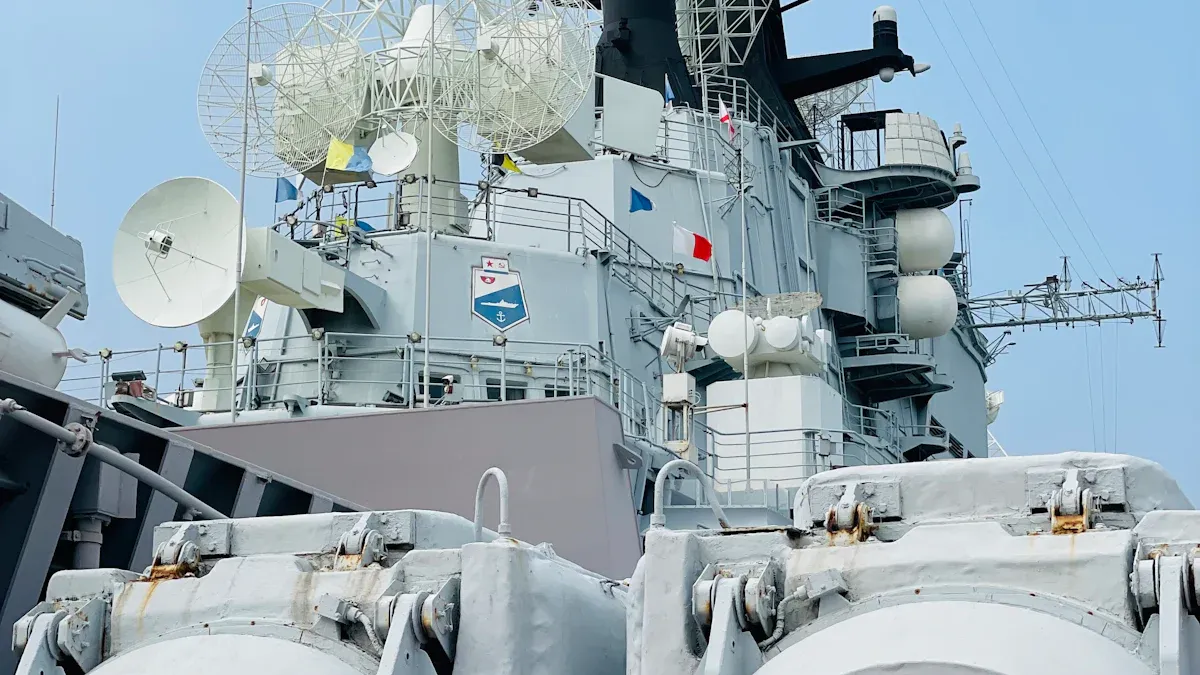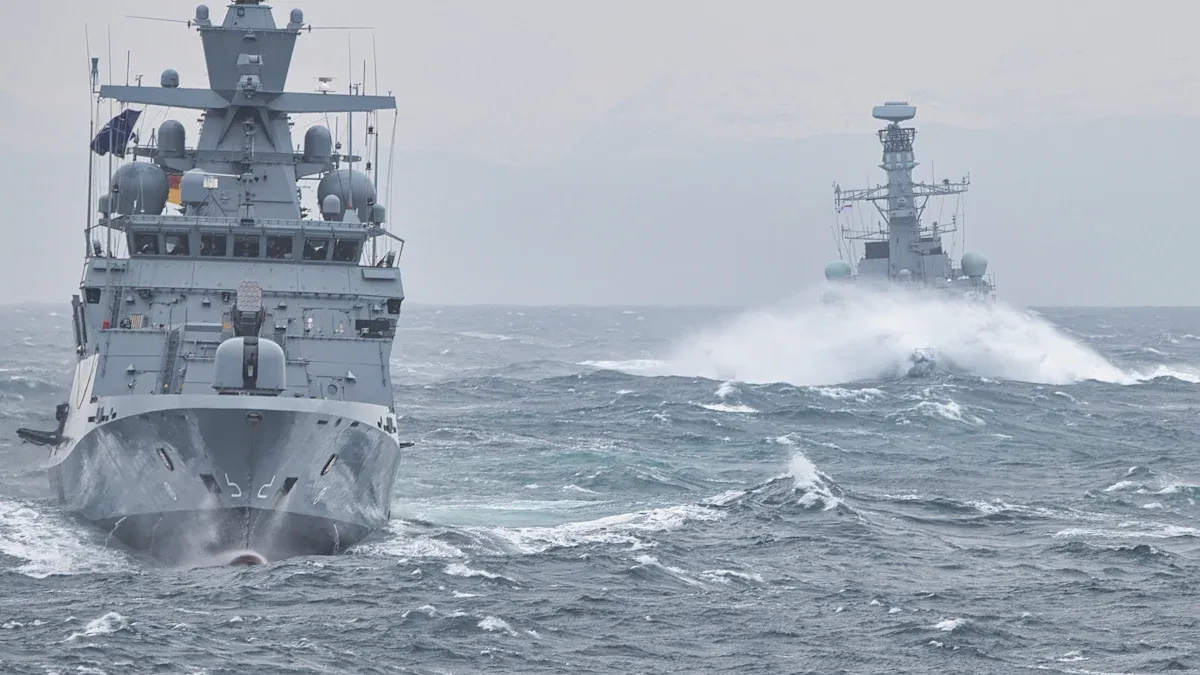
Marine industrial telephones in 2025 redefine maritime communication. These devices, like the waterproof industrial telephone, combine rugged design with advanced technology to endure harsh conditions. The analog weatherproof telephone ensures reliable connectivity, even during storms. For high-risk zones, the emergency explosion proof telephone enhances safety, offering dependable communication in emergencies.
Overview of Marine Industrial Telephones in 2025

Key Trends in Marine Communication Technology
The marine communication landscape in 2025 reflects a dynamic shift driven by innovation and industry demands. Regulatory requirements and safety protocols have pushed manufacturers to develop more robust and reliable communication systems. Key advancements include the integration of satellite technology, digital radio systems, and unified maritime communication platforms. These innovations ensure seamless connectivity, even in remote oceanic regions.
The rise of autonomous vessels has further accelerated the adoption of advanced communication tools. These vessels rely on real-time data exchange for remote monitoring and control, making cutting-edge marine industrial telephones indispensable. Additionally, the growing emphasis on maritime security has led to the development of encrypted communication systems, ensuring secure and uninterrupted operations.
- Key drivers shaping the market:
- Technological advancements in satellite systems and digital radios.
- Increased demand for integrated solutions for remote and offshore operations.
- Enhanced focus on safety and regulatory compliance.
Importance of Advanced Telephones in Marine Industries
Marine industrial telephones play a pivotal role in ensuring operational efficiency and safety across various maritime sectors. These devices are essential for industries such as oil and gas exploration, offshore construction, and cargo shipping. Their ability to withstand extreme weather conditions and provide reliable communication makes them invaluable in critical situations.
According to the Marine Communication Systems Market Report 2025, the global market for these systems is projected to grow significantly, with a compound annual growth rate (CAGR) expected to rise steadily through 2033. The report highlights the segmentation of the market by type, including radio and satellite phones, and by application, such as emergency response and industrial operations.
| Aspect | Details |
|---|---|
| Report Title | Marine Communication Systems Market Report 2025 (Global Edition) |
| Market Size | Projected at XX Million |
| CAGR | Expected growth rate from 2025 to 2033 is XX% |
| Segmentation | Split by type (Radio, Satellite Phone, Other) and application (Oil And Gas, Offshore, etc.) |
| Additional Analysis | Includes ESG Analysis, SWOT Analysis, and Consumer Behavior Analysis |
These telephones not only enhance connectivity but also reduce operational costs by minimizing downtime caused by communication failures. Their integration into existing systems ensures seamless operations, making them a cornerstone of modern marine industries.
Top Marine Industrial Telephones with Advanced Features

ICOM IC-M510 EVO – Multifunctional VHF Marine Transceiver
The ICOM IC-M510 EVO stands out as a versatile and innovative marine communication device. Designed for modern maritime operations, this VHF transceiver offers advanced features that enhance both functionality and user experience. Its built-in Wi-Fi capability allows seamless integration with smartphones and tablets, enabling remote control and monitoring. This feature proves invaluable for crew members who require flexibility in managing communications.
The device also supports NMEA 2000 connectivity, ensuring compatibility with other onboard systems. This integration simplifies data sharing and improves operational efficiency. Additionally, the IC-M510 EVO boasts a large, high-resolution display that provides clear visibility, even in bright sunlight. Its waterproof construction ensures durability in harsh marine environments, making it a reliable choice for professionals.
Key Features:
- Built-in Wi-Fi for remote operation.
- NMEA 2000 compatibility for seamless system integration.
- Waterproof design with IP68 rating.
- Large, easy-to-read display for enhanced usability.
Cobham SAILOR 3965 UHF Fire Fighter – Rugged and Reliable Communication
The Cobham SAILOR 3965 UHF Fire Fighter sets a new standard for rugged communication devices in the maritime industry. Specifically designed for firefighting teams, this Marine Industrial Telephone ensures reliable communication in high-risk situations. Its robust construction meets stringent safety standards, including ATEX and IECEx certifications, making it suitable for use in explosive environments.
This device features a user-friendly interface with large buttons, allowing easy operation even while wearing gloves. Its long battery life ensures uninterrupted communication during extended operations. The SAILOR 3965 also includes noise-canceling technology, which guarantees clear audio in noisy environments. These features make it an indispensable tool for emergency response teams.
Key Features:
- ATEX and IECEx certified for use in hazardous areas.
- Noise-canceling technology for clear communication.
- Ergonomic design with glove-friendly buttons.
- Extended battery life for prolonged use.
Pro Tip: The Cobham SAILOR 3965 is ideal for emergency scenarios where safety and reliability are paramount.
Entel HT944 Series – Military-Grade Durability and Performance
The Entel HT944 Series exemplifies military-grade durability and performance, making it a top choice for demanding marine operations. Built to withstand extreme conditions, this Marine Industrial Telephone features an IP68 waterproof rating and shock-resistant construction. Its robust design ensures reliable performance in the harshest environments, including heavy rain, saltwater exposure, and extreme temperatures.
The HT944 Series offers advanced communication capabilities, including digital and analog modes, ensuring compatibility with various systems. Its high-capacity battery provides extended operational hours, while the intuitive interface simplifies usage. This series also includes programmable buttons, allowing users to customize functions based on their specific needs.
Key Features:
- IP68 waterproof and shock-resistant design.
- Dual-mode operation (digital and analog) for system compatibility.
- Programmable buttons for customizable functionality.
- High-capacity battery for extended use.
Note: The Entel HT944 Series is perfect for industries requiring robust and versatile communication tools, such as offshore construction and oil exploration.
How These Features Are Changing Communication
Enhanced Safety and Reliability
Modern marine industrial telephones significantly enhance safety and reliability in maritime operations. These devices ensure uninterrupted communication, even in hazardous conditions, reducing risks during emergencies. Features like ATEX and IECEx certifications enable safe usage in explosive environments, while noise-canceling technology ensures clear communication in noisy settings.
A study highlights the impact of these advancements:
| Impact Type | Description |
|---|---|
| Qualitative | Improvement in effectiveness and efficiency of business processes in seaports. |
| Qualitative | Enhanced collaboration and interoperability among supply chain actors. |
| Qualitative | Increased vessel safety and security through improved operational scheduling. |
| Quantitative | Potential 30% reduction in planning time for handling bookings. |
| Quantitative | 3-4.5% decline in slot reservation conflict rates with SOTDMA protocol. |
These features collectively improve operational safety and streamline processes, making them indispensable for maritime industries.
Improved Connectivity in Remote Areas
Marine industrial telephones revolutionize connectivity in remote oceanic regions. Satellite phones, for instance, provide reliable communication independent of cellular networks. Networks like Iridium offer global coverage, including polar areas, ensuring seamless communication for vessels operating in isolated waters.
- Satellite phones maintain connectivity despite environmental challenges.
- Comprehensive coverage by networks like Iridium supports operations in polar and remote regions.
- Connectivity improvements reduce communication gaps, enhancing operational efficiency.
These advancements ensure that vessels remain connected, regardless of their location, fostering better coordination and safety.
Cost-Efficiency and Operational Benefits
Advanced marine industrial telephones reduce operational costs by minimizing downtime caused by communication failures. Their durability and integration capabilities lower maintenance expenses and improve workflow efficiency. For example, programmable features and compatibility with existing systems streamline operations, saving time and resources.
These devices also enhance collaboration among supply chain actors, reducing delays and improving scheduling accuracy. By optimizing communication, they contribute to cost-effective and efficient maritime operations.
Factors to Consider When Choosing a Marine Industrial Telephone
Durability and Weather Resistance
Marine environments are harsh, with exposure to saltwater, extreme temperatures, and high humidity. A marine industrial telephone must withstand these conditions to ensure reliable performance. Devices with IP68 ratings offer excellent protection against water and dust, making them suitable for prolonged use in challenging environments. Shock-resistant designs further enhance durability, ensuring the device remains functional even after accidental drops or impacts.
For industries like offshore oil exploration, where equipment faces constant exposure to corrosive elements, weather-resistant materials such as stainless steel or reinforced polymers are essential. These features not only extend the lifespan of the device but also reduce maintenance costs, making them a practical choice for long-term operations.
Connectivity Options and Range
Reliable connectivity is crucial for maritime operations, especially in remote areas. Modern marine telephones offer various connectivity options, including satellite, cellular, and Wi-Fi. Each option provides unique advantages:
- Marine Wi-Fi receivers can maintain connectivity up to 12 miles offshore, depending on the originating source.
- Cellular networks often extend several miles offshore, with coverage maps sometimes underestimating actual performance.
- Ordinary mobile phones remain effective within a mile or two of coastal areas, depending on the carrier.
Selecting a device with multiple connectivity options ensures uninterrupted communication, even in isolated regions. This versatility enhances operational efficiency and safety.
Ease of Use and Integration with Existing Systems
User-friendly interfaces and seamless integration with existing systems are critical for efficient operations. Case studies highlight the importance of compatibility:
| Case Study | Description | Compatibility |
|---|---|---|
| Plantation Boat Mart | Developed an app for customer management and boat tracking. | Compatible with both new and retrofitted boats. |
| Bluewater Boats | Retrofitted existing boats to enhance telemetry and community engagement. | Works with all Bluewater boats, regardless of age. |
| Vtech Boats | Created a compact telemetry module for essential monitoring. | Compatible with Vtech’s mobile app and insurance tracking needs. |
Devices that integrate easily with telemetry systems or apps simplify workflows and improve productivity. This compatibility reduces training time and ensures smooth adoption across teams.
Advanced marine industrial telephones are reshaping maritime communication in 2025. These devices enhance safety, connectivity, and operational efficiency, making them essential for modern marine operations. Their durability ensures reliability in extreme conditions. By adopting these innovative tools, industries can optimize communication systems and meet the demands of challenging environments.
FAQ
What makes marine industrial telephones essential for maritime operations?
Marine industrial telephones ensure reliable communication in harsh environments. They enhance safety and operational efficiency, making them indispensable for modern maritime industries.
How do these telephones improve connectivity in remote areas?
These devices utilize satellite and digital radio technologies. They provide seamless communication even in isolated oceanic regions, ensuring vessels remain connected.
Are these telephones cost-effective for marine industries?
Yes, they reduce operational costs by minimizing downtime. Their durability and integration capabilities lower maintenance expenses, optimizing workflow efficiency.


